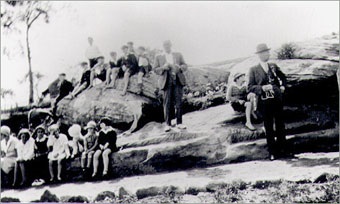Princes Regent Swimming Club
In the 1850s a schoolboy from Gladesville named Walter Campbell often went swimming with his friends in the Parramatta River. Years later he recalled that it was a great amusement for men and boys at that time but that girls and women had few opportunities for saltwater bathing. The customs of the day required "ladies" to swim in bathing sheds and enclosures segregated from men, although Campbell remembered that in Ryde there was one secluded spot near Looking Glass Point where "a few ladies had an occasional dip".
Photo: Mrs Linda Randall cutting the ribbon on opening day at the Princes Regent Swimming Club baths. Parramatta River, Ryde - 8 October 1932
As early as 1877 Ryde Council discussed the desirability of building public baths but soon abandoned the idea as being too expensive. The issue was revived in 1887 when a young man was killed by a 16 foot shark whilst swimming near Ryde Wharf. But it was not until late 1904 that things got moving. A site was chosen on the edge of the Parramatta River at the bottom of Osborne Avenue. Plans were prepared and tenders called.
The Ryde Swimming Baths were officially opened on 30 January 1905. Speaking at the opening ceremony, the Minister for Works expressed the view that in Australia's climate "easy access to salt water bathing was the foundation of health to a large degree."
He hoped that the baths would be accessible to "ladies" since "every girl and woman should be able to swim, as well as every man and boy". Women and girls were allowed to swim between 9am and 5pm on Tuesdays and Fridays but a set of by laws forbade mixed bathing. Other baths were built along the Parramatta River around this time. The Glades Bay baths were built by Council at the bottom of Ross Street Gladesville in 1909.
In 1918 baths at Tennyson were erected by the Tennyson Swimming Club with Council providing the necessary material. Private baths on the riverside at Putney Park and Meadowbank came under Ryde Council's control in the late 1920s.
In the summer of 1930 the Meadowbank baths were so popular that Council found it necessary to prosecute people who allowed their dogs to enter the water "to the inconvenience of the bathers". Rules against sun-baking were strictly enforced. Lying about a public bathing reserve clad only in bathing costume was considered vulgar and only permitted in special sun-basking enclosures. In the depression years of the late 1920s and 1930s the costs of maintaining the various riverside baths became a major concern for Ryde Council. Netting and timber enclosures quickly fell into disrepair and rotted away. Vandalism was a problem unless caretakers lived near the baths. By late 1930 the baths at the bottom of Osborne Avenue had become derelict and were demolished.
Sharks were frequently seen in the river at this time and stories of dogs being taken by sharks were common. In January 1932 representatives of around 20 families who lived in the area bounded by Princes, Regent, Wade, Osborne and Waterview Streets got together to plan the building of a sharkproof baths at the bottom of Regent Street. The families wanted a safe place for their children to learn to swim. They formed a committee and called themselves the Princes Regent Swimming Club.
With Council's support the club obtained a lease from the Sydney Harbour Trust. Construction work was carried out by club members themselves, working on weekends and at low tide. While the men sunk posts and erected mesh the women supplied morning and afternoon teas. The enclosure measured 210 feet by 45 feet with 78 tons of filling put into the baths to provide a sandy bottom.
On the east the pool was fringed by mangroves and on the west it was bounded by rocks. Little gardens were made in the rock crevices and a buffalo grass lawn was made in front of the pool. A turnstile was installed, a sign posted and a flagpole raised. The baths were opened with a ribbon cutting ceremony on Saturday October 8 1932. The Cumberland Argus & Fruitgrowers Advocate reported the event, remarking that the baths were the result of a "fine voluntary community effort."
 Photo: Children on rocks at Princes Regent Swimming Club opening, 1932
Photo: Children on rocks at Princes Regent Swimming Club opening, 1932
The newspaper noted too that they had been opened "free of debt" and explained that the families involved had contributed a weekly sum to the project. Members of the club recall that their families also organised euchre parties and dances as fund raising events. The card parties mostly took place in the homes of those members of the committee who had big back rooms. The dances were usually held in Milligan's Hall in Delange Road Putney. Children's fancy-dress concerts were also organised. Fund-raising continued after the baths opened in order to meet the costs of maintenance. Regular working bees were held to keep the baths clean and remove seaweed.
Until the war years the club held an annual Christmas party in the old Ryde Town Hall on the corner of Blaxland Road and Tucker Street. But in the years following the war, as the children of the club's founding families grew up, married, or moved away from the district, the necessity for the club declined. Steadily increasing effluent pollution also made the Parramatta River less and less attractive as a place to swim.
Since the 1930s a movement towards Olympic standard freshwater swimming pools had been developing in Australia, fuelled by Australian successes at the 1932 Los Angeles Olympic Games. The 1956 Melbourne Games provided the final impetus which eventually led to the opening of the Ryde Swimming Centre in 1961.
Written by Megan Martin, former Local Studies Librarian, Ryde Library Services, with thanks to ex-members of the Princes Regent Swimming Club. January 1995.